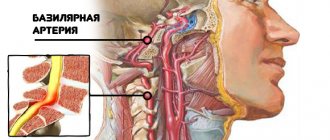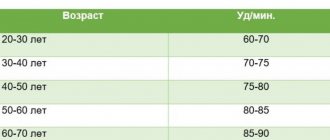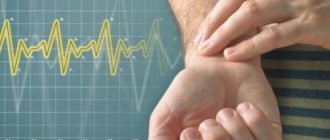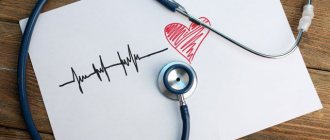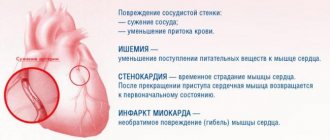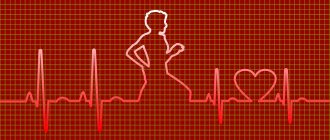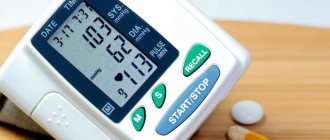Pathologies of the cardiovascular system are accompanied by pulse disturbances in 85-90% of cases. Spontaneous deviations in cardiac activity occur in 100% of situations, which indicates the absolute prevalence of dysfunctions of this kind.
The most obvious option for the patient himself is tachycardia (increased heart rate).
There are two types of this pathological condition:
- Sinus form. It is represented by a disruption of the normal generation of an electrical impulse by the natural pacemaker (sinus node), located in the right atrium.
- Paroxysmal. It is determined by the formation of new, abnormal foci of activity. It occurs somewhat less frequently, flows more severely and is generally considered more life-threatening.
A pulse of 120 heart beats per minute is characteristic only of the sinus type; for the second, figures of 140 and higher are pathognomonic. This type of deviation does not pose any danger.
Does this mean that you can sit with your hands folded? No, definitely. On the one hand, over time, the acceleration of cardiac activity can progress, turning into something else: extrasystole, or ventricular fibrillation.
On the other hand, a pulse of 120-125 is almost always secondary and caused by other diseases. It is not known what we are talking about, therefore, fatal complications are quite likely.
Causes of pathology
A heart rate of 120 beats per minute is tachycardia. There are several reasons for its development. Most are transient in nature, and only a few are capable of creating a risk to human health and require emergency medical intervention.
Physiological
Temporary functional reasons that cause a rapid pulse include:
- unhealthy lifestyle: psycho-emotional overexcitation, stress - anything that can change the electrolyte balance of the myocardium (imbalance of potassium, sodium, calcium and magnesium) and increase the heart rate;
- excessive physical activity;
- pregnancy.
Pathological
Reasons that can cause organic changes in organs and tissues against the background of a pulse of 120-125 beats/minute at rest include:
- diseases of the heart, blood vessels, and other vital internal organs (ischemic heart disease, myocarditis, pulmonary embolism (PE), AMI, genetically determined syndromes, cardiomyopathies of various origins);
- tissue hypoxia or ischemia;
- diseases of the bronchopulmonary system;
- dehydration of various origins;
- uncontrolled use of drugs with intoxication;
- dysfunction of the thyroid gland (hyperthyroidism);
- VSD;
- obesity;
- diabetes;
- anemia of any etiology;
- hyperthermia (+ one degree increases the pulse by an average of 10 beats/minute).
Tests needed to identify the root cause
Under the supervision of a cardiologist. The approximate list of events is quite wide:
- Oral questioning of the patient and collection of anamnesis. Aimed at objectifying symptoms and identifying the clinical picture.
- Next, measure blood pressure and heart rate. Statement of the fact of deviation from the norm.
- 24-hour Holter monitoring. Registration of the same indicators for 24 hours. Makes it possible to assess the situation in dynamics, in natural conditions for the patient.
- Electrocardiography. Shows the functional state of the cardiovascular system. Can be prescribed after exercise (bicycle ergometry).
- Echocardiography. Ultrasound technique for tissue visualization. All defects become clearly visible.
If necessary, cardiac tomography and coronography are indicated. It is possible to prescribe vascular Doppler ultrasound (USDG).
A cardiologist does not always cope alone. When the origin of the pathological process is complex, third-party doctors are involved. It is possible to convene a whole council, based on the complexity of the case.
What is the danger?
A pulse of 120 beats/minute is characteristic of the sinus type, and in itself, existing for a limited time, does not pose a great danger. At the same time, on the one hand, over time, tachycardia creates a risk of transition to extrasystole, or ventricular fibrillation. On the other hand, it indicates the progression of some primary disease, for which fatal complications are quite likely. These dangerous consequences lead to:
- Congenital anomaly of the conduction system (the presence of additional branches of the conduction system of the heart, which duplicate the impulse, interfering with the full functioning of the myocardium, the full release of blood), which leads to brain hypoxia, fainting, and loss of consciousness.
- Acquired pathologies: hypertension, atherosclerosis, hyperthyroidism with the development of atrial fibrillation or ventricular fibrillation. The main danger is the formation of intracardiac blood clots, their separation, and ischemic stroke with a high risk of death.
You can minimize or prevent the danger using special techniques to lower your heart rate:
- periodic holding of breath to activate the vagus nerve, which can tame tachycardia;
- Valsalva maneuver: holding your breath with simultaneous abdominal tension - the essence is the same, activation of the vagus nerve;
- Aschner's test - pressing with fingers on closed eyes, the essence is the same;
These techniques can help slow your heart rate, but they are done either by a doctor, under the supervision of a doctor, or as prescribed by a doctor. Self-medication can lead to unpredictable consequences.
What do these indicators mean?
Usually nothing specific. It is possible to state a fact: heart rate acceleration. The pathological process is almost never primary.
It may be due to the onset of the disease or natural factors. If some third-party diagnosis is to blame, there are plenty of options. Not always cardiac abnormalities. Neurogenic processes and gland dysfunction are possible.
You need to figure it out together with your doctor. You should start with a cardiologist, then involve other specialists as necessary.
Sinus tachycardia, for which typical values are 100-130 maximum, is relatively difficult to tolerate, but the danger to life in the early stages is minimal.
In some cases, it is impossible to determine the cause of the condition even after a thorough examination. Then they talk about the idiopathic form of the increase in the indicator.
First aid
If your pulse begins to race, you need to calm down, drink cool water, lie down and take repeated measurements in about twenty minutes. Once your heart rate is normal, there is no cause for concern.
If dangerous symptoms are added to a pulse of 120 beats/minute: hyperthermia, abdominal pain, cardialgia, lightheadedness or fainting, you should call an ambulance. Before doctors arrive, you need to minimize movements and not take any medications. The exception is sedative drops: Valerian, Motherwort, Corvalol, Valocordin and Validol under the tongue. You should open the window and measure blood pressure.
If the cause of tachycardia is well known and attacks occur frequently, there is a drug regimen approved by the doctor, then you need to put Anaprilin under the tongue, take a Cordarone capsule or a Propanorm tablet. For high blood pressure - a common antihypertensive drug.
In all other cases, all medications are excluded before the doctors arrive.
Average normal heart rate and upward deviations
Each age has a medical indicator of the normal pulse rate (Table 1). For example, for infants it is 130 beats, for children – 80, for middle-aged people – 60-90, and for the elderly – 65. You also need to take into account the time of day when the indicators are measured.
So, in the morning hours, after the body awakens, the heart muscle works with a frequency of 50-60 beats; during the day, normal values are observed in a healthy person, but in the evening the heart increases its rhythm and a value of 90 is recorded.
Table 1 - Age norms of heart rate
If the patient’s heart rate is constantly within 100, we can talk about tachycardia, that is, a significantly increased heart rate compared to normal values. This is a disease that is diagnosed when the cardiovascular system is not functioning properly. In such patients, the heart muscle, under the influence of physiological or pathological factors, cannot cope with pushing blood into the arteries.
Most often, an increase in heart rate is associated with an increase in blood pressure due to the influence of external factors or due to internal pathologies. But there are times when the pressure remains within normal limits, but the pulse value goes off scale.
This is a sign of serious disorders in the body, which, if not noticed in time and not treated, will lead to wear and tear of the heart muscle, heart attack, heart failure, or even death.
Physiology of tachycardia
In the medical literature, two types of tachycardia are distinguished:
- Physiological – short-term (up to 20 minutes) increase in heart rate associated with physical activity. load, emotional state, stress, nervous tension.
- Pathological – associated with internal pathologies of the body: heart disease, intoxication, the presence of infection or inflammation, vascular and pulmonary diseases, hormonal disorders.
Pulse 120 can be diagnosed for the following reasons:
- alcohol and tobacco consumption;
- binge eating;
- increased air temperature, heat and stuffiness, under the influence of which shortness of breath occurs;
- feeling of fear;
- drinking coffee and tea containing caffeine;
- drug use;
- consumption of energy drinks.
If the indicator rises sharply to 127 beats or higher, you should try to lower it yourself using first aid methods. They will be discussed below.
If it has been noticed that the tonometer constantly shows a pulse of 125 or higher, it is necessary to visit a doctor as soon as possible, undergo an examination and prescribe a course of treatment, since untimely therapy is fraught with negative consequences for the body, including disruption of the functioning of its main systems.
When do you need to call an ambulance?
If the pulse rate of 120-125 beats/minute does not go away within half an hour, you should immediately seek medical help. In addition to tachycardia, the patient may be concerned about:
- chest pain of a pressing or burning nature, of moderate intensity (if this lasts more than half an hour, it is a sign of a developing heart attack);
- shortness of breath, which indicates either increasing heart failure (with complete rest) or impaired gas exchange due to pulmonary pathology;
- cyanosis of the nasolabial triangle against the background of unnatural pallor of the skin;
- a heart rhythm disturbance (extrasystole or fibrillation) can develop in parallel with a rapid heartbeat, with a characteristic feeling of a freezing heart;
- cold, profuse, sticky sweat is a consequence of vegetative-vascular disorders;
- headaches of different nature and genesis are the result of ischemia and hypoxia of brain structures;
- dizziness, sometimes of an orthostatic nature against the background of low blood pressure, loss of orientation in space with a forced lying position;
- increasing ringing in the ears;
- syncope, presyncope and fainting are one of the worst prognostic signs that indicate persistent progressive cerebral ischemia resulting in stroke;
- fear, panic attacks or complete apathy require immediate correction.
Such symptoms are treated only inpatiently and only by qualified specialists. In some cases, time passes by minutes.
Diagnostics
Measures to eliminate the increase in heart rate should be taken immediately when symptoms are detected. Before prescribing treatment, the doctor will conduct a detailed examination, collect anamnesis, and find out whether any of the patient’s family members suffered from cardiovascular pathologies. To determine why the pulse fluctuates despite normal blood pressure readings, a comprehensive diagnosis is needed.
The recommended list of examinations includes:
- general blood tests and for biochemical composition - here signs of chronic inflammation in the body, lack of hemoglobin and other problems may appear;
- ECG – to assess the functioning of the heart;
- taking blood for analysis of hormone levels - allows you to identify incipient diseases of the endocrine system;
- daily monitoring of blood pressure and heart rate to record the time of increase in pulse and the conditions predisposing to it;
- Ultrasound of the heart;
- Ultrasound of the abdominal organs, liver, kidneys.
Performing an ultrasound of the heart
If consultation with additional specialists is required, the patient is referred to a neurologist, endocrinologist, or ENT doctor, depending on the root cause of the signs of arrhythmia.
Features of treatment
Therapy for a pulse of 120 beats/minute is usually medicinal. Drugs of different pharmacological groups are used:
- cardiac glycosides: Strophanthin, Korglykon, Digoxin, Celanide - improve myocardial contractility, but are used with great caution, minimal doses and short courses, since they have the ability to accumulate, causing sudden cardiac arrest;
- beta blockers: Betaloc, Concor, Metoprolol, Carvedilol according to indications;
- antiarrhythmics: Anaprilin, Amiodarone - in small courses;
- antihypertensive drugs: Renitek, Ko-Renitek, Norvasc, Enap, Amlodipine - for high blood pressure with a tendency to further increase;
- sedatives: Novo-Passit, Persen, Afobazol - to stabilize the psycho-emotional background.
Surgery with a pulse of 120-125 beats/minute is carried out according to vital indications: heart defects - congenital and acquired, total atherosclerosis requiring balloon angioplasty, stenosis with stenting. It is possible to ablate (cauterize) the focus of pathological myocardial activity with radio waves or install a pacemaker (pacemaker).
In all cases, the heart rate is 120 beats/minute, a priori a change in lifestyle is assumed: giving up alcohol, cigarettes, a balanced diet with salt limited to 5-7 grams/day, dosed physical activity.
With sinus tachycardia 120 beats/minute, using folk remedies is pointless and even dangerous due to the risk of complications (dosage inaccuracy).
